Добрый день, Коллеги. Важное сообщение, просьба принять участие. Музей Ферсмана ищет помощь для реставрационных работ в помещении. Подробности по ссылке
Geology and geochemistry of the Cortez gold deposit, Nevada
Gold has been discovered recently at Cortez, Nevada, about 45 miles southwest of Carlin in carbonate rocks in a window of the Roberts Mountains thrust. The host rock consists of laminated to thin-bedded dark- to light-gray, silty dolomitic limestone and calcareous dolomitic siltstone in the upper part of the Silurian Roberts Mountains Limestone. These rocks contain sparse pyrite cubes and aggregates and some organic carbon. The rocks have been faulted and folded repeatedly during their complex geologic history. The gold is disseminated in a large zone where the rocks have been fractured and bleached and the pyrite oxidized. During oxidation the iron was redistributed, giving the rock a color ranging from light gray to dark red. The alteration zone envelops a 34-m.y.-old intrusive body of biotite-quartz-sanidine porphyry, which is also altered. No genetic relationship between the mineralization and the intrusive body is known. Silicification, iron-oxide staining, decalcification and, in extreme cases, dedolo-mitization generally accompanied the gold metallization, although any one of these phases of hydrothermal alteration may have been well developed without introduction of significant amounts of gold. Some clay alteration occurred in the igneous rock but none in the ore body. The gold is in micron-sized particles of native gold. Gold is mostly with silica between original silt grains and to a lesser extent in quartz-filled microfractures and hematite-goethite pseudomorphs after pyrite.
The gold was discovered during the examination of an arsenic-antimony-tungsten-mercury geochemical anomaly known in the area. Other gold deposits in north-central Nevada are associated with such anomalies.




